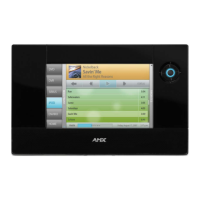Protected Setup Pages
58
MVP-5200i Modero® ViewPoint® Touch Panel with Intercom - Instruction Manual
WEP
In the Wireless Security: Simple Mode popup window (FIG. 61), press the Security Type field to select WEP.
WEP security requires that both a target AP be identified and an encryption method be implemented prior to establishing
communication. In addition to providing both Open and Shared Authentication capabilities, this page also supports Hexadecimal
and ASCII keys.
Refer to the Configuring Wireless Network Access section on page 29 and the Using the Site Survey Tool section on page 30 for
further details on these security options.
WEP Settings
WEP 64 / WEP 128: Cycles through the available encryption options: 64 or 128 Bit Key Size.
“WEP” (Wired Equivalent Privacy) is an 802.11 security protocol designed to provide wireless security equivalent to
wired networks.
• WEP64 enables WEP encryption using a 64 Bit Key Size. All packets are transmitted with their contents encrypted
using the Default WEP Key.
• WEP128 enables WEP encryption using a 128 Bit Key Size. All packets are transmitted with their contents
encrypted using the Default WEP Key.
If the key is not the correct size, the system will resize it to match the number of bits required for the WEP
encryption mode selected.
SSID: Opens an on-screen keyboard to enter the SSID name used on the target AP. The SSID is a unique name used by the
AP, and is assigned to all panels on that network. An SSID is required by the AP before the panel is permitted to join
the network.
• The SSID is case sensitive and must not exceed 32 characters.
• Make sure this setting is the same for all points in your wireless network.
• If this field is left blank, the panel will attempt to connect to the first available AP.
WEP Keys: This feature provides another level of security by selecting up to four WEP Keys.
Push any of the four buttons to open an on-screen keyboard. Both ASCII and HEX keys are supported. Up to four
keys can be configured for both.
• An ASCII key utilizes either 5 or 13 ASCII characters
• A HEX key utilizes either 10 or 26 Hexidecimal characters
Press Done to accept any changes and save the new value.
Note: A 64-bit key will be 10 characters in length while a 128-bit key will be 26 characters in length. The length of the
key entered determines the level of WEP encryption employed (64 or 128-bit). 128-bit keys may be used if supported
by the internal wireless card.
Default Key: Cycles through the four available WEP key identifiers to select a WEP key to use. As the Default Key value is altered
(through selection) the corresponding “Current Key” is displayed. Each Current Key corresponds to a WEP key.
This feature is useful for accessing different networks without having to re-enter that networks’ WEP key. It is also
sometimes used to set up a rotating key schedule to provide an extra layer of security.
WEP Keys: This feature provides another level of security by selecting up to four WEP Keys.
Push any of the four buttons to open an on-screen keyboard. Both ASCII and HEX keys are supported. Up to four
keys can be configured for both.
• An ASCII key utilizes either 5 or 13 ASCII characters
• A HEX key utilizes either 10 or 26 Hexidecimal characters
Press Done to accept any changes and save the new value.
Note: A 64-bit key will be 10 characters in length while a 128-bit key will be 26 characters in length. The length of the
key entered determines the level of WEP encryption employed (64 or 128-bit). 128-bit keys may be used if supported
by the internal wireless card.
Authentication: Toggles between the two authentication modes: Open (broadcast publicly) or Shared (encrypted).
•An Open network allows connections from any client without authentication.
•A Shared network requires the client to submit a key which is shared by the network AP before it is given
permission to associate with the network. In this case the key is the same as the WEP encryption key.
In either case, if WEP encryption has been enabled, the client will still require the WEP key to encrypt and decrypt
packets in order to communicate with the network.
Cancel/Save: • Cancel - discard changes and return to the previous page.
• Save - store the new security information, apply changes, and return to the previous page.

